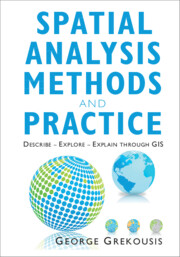Book contents
- Spatial Analysis Methods and Practice
- Reviews
- Spatial Analysis Methods and Practice
- Copyright page
- Contents
- Preface
- 1 Think Spatially
- 2 Exploratory Spatial Data Analysis Tools and Statistics
- 3 Analyzing Geographic Distributions and Point Patterns
- 4 Spatial Autocorrelation
- 5 Multivariate Data in Geography
- 6 Modeling Relationships
- 7 Spatial Econometrics
- References
- Index
5 - Multivariate Data in Geography
Data Reduction and Clustering
Published online by Cambridge University Press: 20 May 2020
- Spatial Analysis Methods and Practice
- Reviews
- Spatial Analysis Methods and Practice
- Copyright page
- Contents
- Preface
- 1 Think Spatially
- 2 Exploratory Spatial Data Analysis Tools and Statistics
- 3 Analyzing Geographic Distributions and Point Patterns
- 4 Spatial Autocorrelation
- 5 Multivariate Data in Geography
- 6 Modeling Relationships
- 7 Spatial Econometrics
- References
- Index
Summary
This chapter deals with multivariate statistical methods for data reduction and clustering, commonly used in geographical analysis, including
Principal component analysis
Factor analysis
Multidimensional scaling
Hierarchical clustering
-means clustering
Regionalization (SKATER, REDCAP)
Density-based clustering (DBSACN, HDBSCAN, OPTICS)
Similarity analysis (cosine similarity)
After a thorough study of the theory and lab sections, you will be able to
Understand why multivariate data and statistics are essential in geographical analysis such as in geodemographics
Understand that observations in multivariate data sets are points in a multidimensional data space
Understand what principal components are and how they can be mapped in a GIS environment
Map multidimensional datasets to a 2-D or 3-D representation by multidimensional scaling
Understand why hierarchical clustering is important to identify the structure of clusters
Use the k-means algorithm in a geographical problem
Evaluate the importance of taking into account spatial constraints when clustering (regionalization)
Use density-based clustering to analyze large datasets of point entities
Apply similarity analysis to identify common characteristics (profiles) on your spatial entities
Perform principal component analysis, multidimensional scaling and hierarchical clustering in Matlab
Conduct k-means clustering, similarity analysis and spatial clustering in ArcGIS
Conduct k-means clusteringand spatial clustering in GeoDa
Keywords
- Type
- Chapter
- Information
- Spatial Analysis Methods and PracticeDescribe – Explore – Explain through GIS, pp. 275 - 350Publisher: Cambridge University PressPrint publication year: 2020



